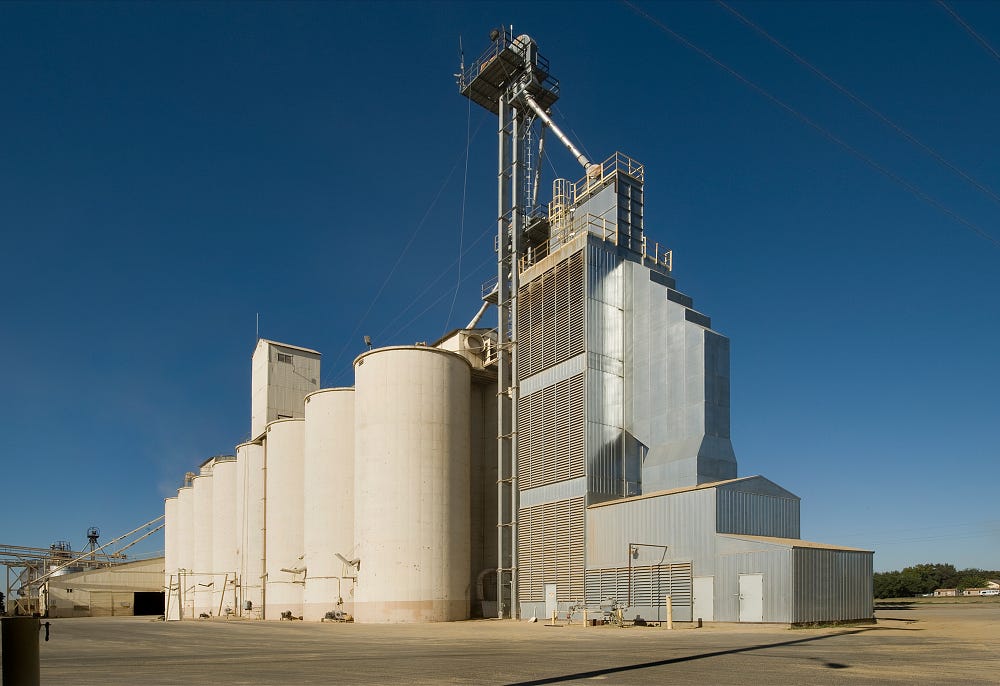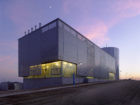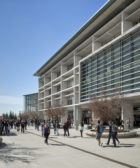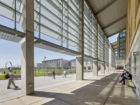If you’ve driven from Los Angeles to San Francisco along Interstate 5 — that perfectly straight highway surrounded by open fields and farmland — then you have a sense for the vast horizons of California’s agrarian heartland, the San Joaquin Valley.
As part of the expansive Central Valley, which stretches some 450 miles through the interior of the state, it’s one the most productive growing regions in the world. For generations, the Valley has been synonymous with agriculture — it yields a third of the nation’s fruit and vegetables, along with incredible amounts of milk, olive oil, rice, and nuts (80 percent of the world’s supply of almonds is grown here).
This bounty has long underpinned California’s status as an economic powerhouse. But until recently, the San Joaquin Valley wasn’t the place you could find a world-class university.
That’s all changed with UC Merced. Founded to meet a growing demand in this underserved region, the newest University of California campus has nearly doubled its size in the past four years — the result of an ambitious campus expansion program with sustainability at its core. Its students come from all over California, with about a third hailing from the region (these are exactly the students who might have otherwise left the San Joaquin Valley for other opportunities if not for UC Merced).
Since 2005, when the first undergraduates arrived on campus, the university has been making good on its mission to expand equity and access to California’s renowned public university system: Of all the UC campuses, Merced has the largest percentage of students from underrepresented ethnic groups and low-income families. More than half are Latino. Some are the children of migrant farm workers. An incredible 75 percent are part of the first generation in their family to attend college.


To accommodate these students, the university’s Merced 2020 Project saw the construction of 11 new buildings — with dormitories, classrooms, teaching spaces, and more — all of which have been certified LEED Platinum. It expands enrollment capacity up to 10,000 students. And in 2018, UC Merced became the first university in the nation to achieve carbon neutrality — two years ahead of an already ambitious schedule.
“Sustainability is a way of life on our campus, but we’re also a leader as a research university,” says Ed Klotzbier, Vice Chancellor for Philanthropy & Strategic Partnerships, External Affairs and Strategic Communications at UC Merced. “Whether you’re talking about climate, water, soil erosion, wildfires — that’s what our first-class researchers are working on. And because we’re a small school, our undergraduates get to do research in those areas, too.”
In short, if you want to see the future of California, you might do well to skip Silicon Valley and head inland — to this less famous valley — and visit a university that didn’t exist two decades ago, with a student body as diverse as the nation’s most populated state.
How exactly did this up-and-coming campus achieve a more progressive sustainability goal than any other American university?
Sustainable from the start
Michael Duncan, an architect and design partner at SOM, has been involved with the design and planning of UC Merced almost since its inception. In 1995, the institution was granted a rural parcel of land near Lake Yosemite Park, about seven miles from the city’s downtown.
“I remember walking the site when nothing was there — just a small golf shack and a bunch of swallows,” Duncan says. The wide-open land was ripe with possibility. “Merced had the chance to do something that the other UCs couldn’t do: They could start from scratch and set a new goal for what a future campus in California could be.”
From the beginning, that goal was defined by environmental performance. The university’s founding chancellor, Carol Tomlinson-Keasey, articulated a clear vision: UC Merced sought to define the research university for the 21st century, and as such, it would set an aggressive agenda to confront the most urgent environmental challenges of our time. Stewardship of the environment would be embedded into every aspect of the university, starting with its design, construction, and operation. Beyond reducing carbon emissions, the university set its sights on “Triple Net Zero”: to ultimately produce as much power as it uses, create zero landfill waste, and achieve climate neutrality.
“We all rallied around this idea that sustainability would be the thing that created the identity for the campus,” says Carrie Byles, a partner at SOM. She has been involved for nearly two decades, along with Duncan and many others, in various stages of the campus’s development.
Defining the campus
Selected to design the original campus master plan, completed in 2002, SOM worked with the fledgling institution to define its physical identity. The team designed some of the first buildings and established the guidelines that would inform a common architectural language as the campus grew — with a focus on creating a sense of place authentic to the region.
“When you drive across the Central Valley, the buildings that stand out are the grain silos, tall and impressive structures, and big agricultural sheds made of corrugated metal. You see a straightforward architecture of expressed structure, a limited palette of materials,” Duncan says. “We took that as a starting point.”

This pared-back architectural approach, informed by the Valley’s agricultural vernacular, goes hand-in-hand with sustainability.
Much of the architecture at UC Merced incorporates passive design strategies to reduce energy needs: projecting sun screens, large overhangs, buildings oriented to shield interiors from the sun. Open-air arcades provide shaded places for students to congregate. With the use of simple materials and unadorned surfaces, such as poured concrete and corrugated metal, the design team countered a common misconception: They showed that sustainable design can be contextual and beautiful — and it doesn’t need to be more expensive.

Planning the infrastructure from the ground up, the team spotted a significant opportunity with the Central Plant, which delivers power and water to the campus. It’s the backbone of UC Merced’s energy system, with a 2-million-gallon thermal tank system for efficiently storing and chilling water. A facility like this would usually be tucked away, but here the plant is located near the heart of campus, with a perforated metal facade that reveals its inner workings. That decision was every bit intentional.
“We thought of the plant as a teaching tool,” Duncan says. “We wanted students to see the machinery inside. From a performance point of view, it’s one of the real drivers of the university.”
Designed to grow
SOM designed the Leo and Dottie Kolligian Library, the first academic building, to initially accommodate a variety of functions: academic offices, administration, information technology, classrooms, and student services. As additional buildings were constructed to fill these roles, the library was seamlessly reconfigured, expanding its dedicated areas for study and research.

Buildings in the first phase of campus development were designed by a range of firms, following the guidelines that SOM had established.

In just a few short years, a thriving community was taking shape. From its opening in 2005, UC Merced progressively phased in new academic and residential buildings. Members of the first graduating class collected their diplomas in 2009, with a rousing commencement speech by First Lady Michelle Obama. And a dramatic turning point came several years later, when the university announced its initiative to accelerate its development: By 2020, it would nearly double the campus footprint, accommodate almost twice as many students, and take UC Merced’s commitment to sustainability and climate action to the next level.
Partnering up for impact
The scale of the Merced 2020 Project, a $1.2 billion investment, is unprecedented. According to the university, it’s the largest social infrastructure project ever completed. With 11 new university buildings constructed in just four years — a timeline unheard of in higher education — it’s also an example of how public-private partnerships (known as P3s) can make it possible for major infrastructure investments to be financed and delivered in record time.

Teaming with the developer Plenary Properties Merced and the contractor Webcor, SOM won a competition for the Merced 2020 Project and got a second chance to shape the university. A project of this scale presented a remarkable opportunity to advance the school’s environmental goals.
“Back when we designed the first master plan, sustainability was not the all-embracing dialogue in the industry that it is now. UC Merced got ahead of that,” Duncan says. “It was already the most sustainable campus in the country. Their mission was solidified. So, how could we double the campus footprint and keep rocketing it forward?”
Economies of scale
The sheer size and ambition of the project, with multiple buildings constructed in a short period, presented an inherent advantage. “It’s one thing to make an individual building sustainable,” Byles says, “but when you’re working at a district level, you can do things like load sharing, you can get energy and water efficiency through district and central facilities.” What’s more, the groundwork was already in place. The team was able to connect the new development with the Central Plant, a solar grid and other highly efficient infrastructure created during the first phase.

The large-scale project also allowed the team to consider big questions about the kind of social and academic environment that the university aspired to create. In the wide-open Valley, there’s nothing but room to build — but instead of suburban sprawl, UC Merced sought to foster the dynamism you’d find at a more urban institution.
Having the best of both worlds was all part of the master plan, says Duncan. Clusters of four- and five-story buildings, taller than anything for miles around, create an “urban street experience” at the heart of campus — yet grounded in a sense of place unique to the Valley, with views out to the landscape beyond. Buildings are clustered into zones of higher density, while natural areas, such as a wetlands zone near the campus, remain open and protected from development.
These natural areas serve as an ideal outdoor laboratory. “Classes are literally held outside in the Merced Vernal Pools and Grassland Reserve,” Ed Klotzbier, the vice chancellor, says. “Students meet at the gate and walk out into the grasslands to conduct field research.”
Another distinctive aspect of the campus planning strategy is that each of the new buildings at UC Merced serves multiple purposes. Classrooms are layered into every building, from residence halls to research facilities.
Leo Chow, an architect and design partner involved with several buildings, describes the logic of this approach:“A classroom in a dorm building might get used for study or for a yoga class in the evening. The classrooms get to have a second life. And it contributes to a sense of community everywhere on campus.” While most capital projects in higher education are built to serve a specific and immediate need, UC Merced’s build-it-all-at-once approach made a more dynamic mix possible.

The Merced 2020 Project saw the construction of the Pavilion, a dining hall that quickly became a popular gathering place on campus. Its simple form and materials are inspired by the agricultural sheds found throughout the Central Valley, with a gently pitched roof that serves to collect and conserve rainwater. Another new facility, the Sustainability Research and Engineering Building, is where students and faculty are advancing UC Merced’s climate-focused mission. With classrooms next to research labs on every floor, the layout creates the possibility for serendipitous discoveries. “Research is not hidden away in an ivory tower, but something that you see every day on your way to class,” Chow says.
Broad horizons for the Valley, and beyond
Through wide-ranging research initiatives, students and faculty are taking on an array of issues related to climate change and the environment.
The Sierra Nevada Research Institute, the first research unit to be established at UC Merced, is dedicated to the stewardship of the unique ecosystem of the broader region — with a focus on interconnected issues of population growth, pollution, climate change, land use policy, and more. Students have the opportunity to conduct field research in Yosemite, which makes Merced the only UC campus to have a dedicated research facility in a national park.
Then there’s UC Solar, an initiative across multiple campuses, dedicated to making solar energy more effective and affordable, through advances in technology, policy, and economics. Meanwhile, UC Merced’s own solar energy system — which generates clean electricity equal to removing approximately 30,000 cars from the road every year — offers a living laboratory for students and faculty to collect data and explore new solar solutions.
And last year, UC Merced announced a program with particular relevance for the Central Valley: a new research center to find applications for technology, AI, and machine learning to transform agriculture. The interdisciplinary initiative is supported by a five-year, $26 million grant from the National Science Foundation.

The interconnected challenges of food, water, and energy security are keenly felt in the Central Valley, which has suffered devastating droughts in recent years. One research team, led by UC Merced computer science and engineering professor Stefano Carpin, is inventing solutions for “precision agriculture.” His team has developed an irrigation robot equipped with AI technology. Roaming the fields, it can detect which crops need water, and which don’t, and use precisely the amount that’s needed — helping farmers to conserve this precious resource. Already being tested in vineyards in the San Joaquin Valley, this research opens up exciting possibilities for how machine learning can support more sustainable farming practices. And it points to a future in which a robust agricultural economy can merge with the technology and innovation sector — unlocking economic potential and creating new opportunities for graduates in the region.

These programs and others show that the physical campus is just the beginning of UC Merced’s commitment to climate action. The academic work and research that’s happening there has the potential to make a far greater impact — in the Central Valley and beyond.